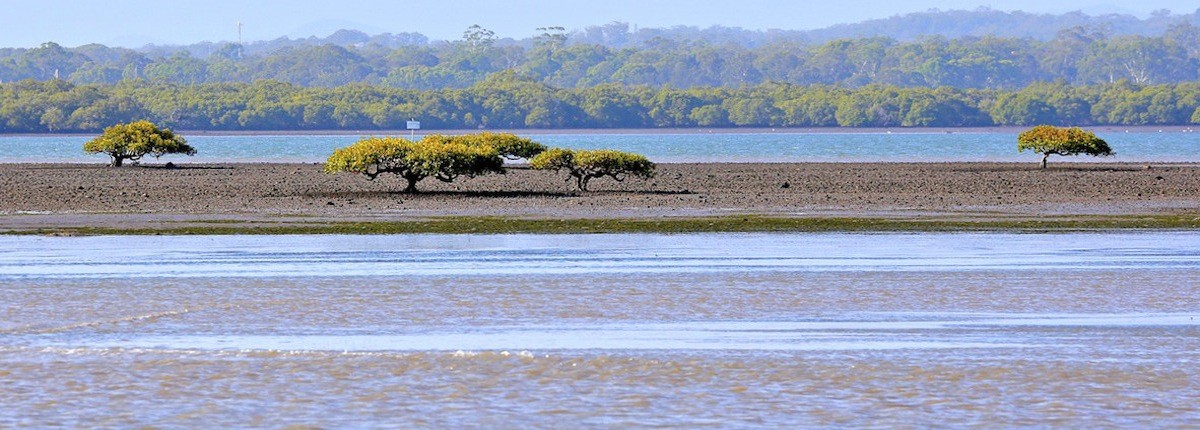About Campaign Contributions
In a book about Australia’s political institutions, its author Gwynneth Singleton, says,
“…it is all too easy for a local council to be dominated by an influential clique, and so charges of corruption have been a regular feature of Australian local government.”
This shameful indictment of the local government sector in Australia, unfortunately applies in large measure to Redland City Council.
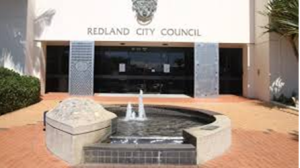
This is not the sort of corruption via cash-stuffed bags, which occurred at the State level in Queensland 30 years ago. Instead a candidate for office strikes an unethical bargain with a wealthy donor by promising to exercise his or her power in office for the benefit of the donor in return for financial assistance with their election campaign.
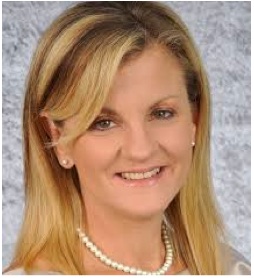
Redland City Council Mayor Karen Williams
These elected Councillors are then obliged to make decisions about important zoning and assessment issues, along with development proposals, based – not on their own merit and in line with the desires of their constituents – but according to the wishes of those who helped finance their election campaign.
In the Redlands, the most divisive issues have been planning decisions. Both the 2004-2008 Council and the 2012 – 2016 Council have operated under a cloud with widely held perceptions of undue developer influence. Why leave our most important council decisions vulnerable like this?
University of Queensland law professor Graeme Orr said because most Councillors stood as independents they were especially vulnerable to corruption.
“It’s easier to corrupt an individual than it is to corrupt a party,” he said.
In 2009, the Nathan Rees government in NSW, had experienced similar problems with developers having undue influence on their local councils. Some Mayors and Councillors were sacked due to their corruption and unethical behaviour. NSW then passed laws banning property developers from making political donations to candidates in local government elections. The laws took effect in January 2010. In October 2015, this ruling was challenged by developers but the NSW High Court upheld the state-wide ban on political donations from property developers.
In Court a question was asked by the developer’s lawyers:
“Why single out the development industry?” The Court replied: “Property developers are sufficiently distinct to warrant specific regulation in light of the nature of their business activities and the nature of the public powers which they might seek to influence in their self-interest”
 Donations from developers isn’t yet illegal here in Queensland, but it could be banned in the near future. Redland City Council recently voted to lobby the State Government to ban all political donations to Councillors including candidates running for elections The vote came after Councillor Craig Ogilvie proposed a motion to ban donations by developers. Craig has campaigned for years to highlight the unhealthy relationships between Redlands Councillors and commercial development interests.
Donations from developers isn’t yet illegal here in Queensland, but it could be banned in the near future. Redland City Council recently voted to lobby the State Government to ban all political donations to Councillors including candidates running for elections The vote came after Councillor Craig Ogilvie proposed a motion to ban donations by developers. Craig has campaigned for years to highlight the unhealthy relationships between Redlands Councillors and commercial development interests.
Annastacia Palaszczuk promised independent MP Peter Wellington her government would instigate a Royal Commission-style inquiry into donations to political parties and candidates in order to win his support in Labor’s bid to form government.
Click on this link for a summary of the shady politics of sandmining on Straddie over the last few years:
http://www.theguardian.com/commentisfree/2014/aug/10/campbell-newman-is-in-quicksand-over-mining-on-stradbroke
Sibelco – the Straddie sand mining company – spent much more than the $90,000 it declared to the Electoral Commission, as the above Guardian article revealed. The Campbell led LNP Government extended sand mining on Straddie following a donor campaign from Sibelco at the 2012 election to assist the LNP and particularly Campbell Newman, get elected.
This shows that a ban must be made not only on mining company and developer donations
but all deep-pocketed business interests – at all levels of government
Our donations and disclosure system at the federal level is woeful and every call for a national integrity body gets buried. We need to be careful we don’t sleepwalk into the same place the US is in. For decades American politics have been a sham, elections bought and paid for by special interests and corporations. We need reforms that strengthen accountability and take steps to bring communities into – and business out of – politics. Post election we will discuss this issue more deeply. For now we’ll focus at the local level.
Ex Division 2 Councillor, Craig Ogilvie has said,
“Imagine a future where:
- the only thing that divides Councillors is a difference of opinion
- the merits of developments are the basis of government decisions
- elections are a contest of ideas and not a contest of dollars
Our finances will be better for it, the environment will be better for it, and our community will be better for it… Anyone who argues that we need to continue to allow developers to fund elections – because the alternative is that the public will have to pay for elections – has no understanding of how much the public is already paying for bad planning and development decisions.”
We have just been to the polls in 2016 to elect a new Council. The City Plan has not been finalised so we must ensure it goes back to the drawing board to preserve our liveability in the Redlands. Mayor Williams has lost her majority but we must be vigilant she doesn’t continue to support development at all costs without proper consideration
When it comes to campaign contributions by developers, it’s not just a problem of ethics, it’s a question of time and money. In Council, the most divisive and time consuming issues are planning decisions, which use up precious resources. The Toondah proposal alone has cost almost $1 million to date and involved many hundreds of hours of work. This diversion of resources starves the Redlands of funds for much needed community infrastructure.
But it’s also about ideas. It’s not uncommon for leadership that lacks integrity to be also lacking in ideas. The intellectual ecosystem becomes bereft of innovation. It’s all a question of priorities and ideas. Choices that are made at the Council level affect the liveability of the Redlands and there are many issues crying out for attention.
See Redlands Opportunities link for new ideas that Council could implement.
Toondah Harbour Development
The present mayor and some of her council acted like hired guns for developers in the 2012 – 2016 term. They showed where their priorities lay – not in the needs of the community -but in the exercise of power, and to maintain that power they need people to remain in ignorance. There was secretive closed door meetings, such as the one a day before last Christmas which resulted in a $116 million infrastructure deal between council and the Walker Group.
Also a premature infrastructure cost-sharing of the $1.39 billion Toondah Harbour redevelopment.
Toondah Harbour will suck the lifeblood out of local residential development. A report into residential development in the city by the planning consultants, Urbis, found there would be no housing shortfall in Redlands and hence no need for any major projects until 2041. The proposed shops and restaurants will also drag business away from the already ailing Cleveland town centre.
The whole process of the Toondah Harbour development has been riddled with incompetence and unnecessary haste at both the local and state levels of government. A preferred developer – the Walker Group – was appointed which, in cahoots with our development crazy council, has resulted in a plan that maximized the number of apartments, commercial premises and marina berths – and thus profit – whilst minimizing importance of things of value such as the environment and infrastructure relating to traffic and adequate car parking.
For such a large and important project, the whole process for the Toondah Harbour development is on the nose. Value for money is threatened by the ‘Preferred Development Partner’ process and a good outcome has been compromised by making the project a Priority Development Area (PDA) where no time was given for a proper Environmental Impact Study and community assessment. The Walker Corporation is headquartered in Sydney and local builders and developers will be squeezed out. A bite-sized development would have given our local construction companies something to chew on.
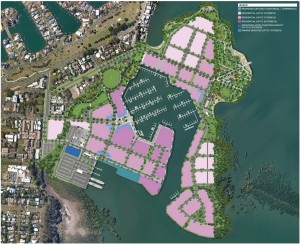
A Priority Development Area (PDA) is used for an area identified for specific accelerated development with a focus on economic growth. The PDA idea was initiated by ‘developer lobbyists’ to the Newman led State government to streamline the planning, approval and development processes to get results. But in this fast tracked process, it becomes an excuse to cut corners and the State Government didn’t exercise the proper controls necessary and with a development hungry council, the PDA streamlining process has resulted in privileging the whims of big business ahead of the community and the environment.
To reclaim such a large area from the sea is a very costly exercise so negotiations would have taken place between State Government and Walkers (the ‘preferred developer’) to increase the scale of the project to obtain critical mass, otherwise the whole thing would not have been viable.
But even if the design was right, experience has shown that for such a complex development, a more competitive tender process could have been established with strict development guidelines set by council after sounding out ferry operators, commuters and the public. And then only after a genuine environmental impact statement based on open enquiry. This process takes longer but achieves better outcomes and we wouldn’t have had the farcically shallow consultation process we’ve had to date.
In fact the Community Organised a Credible Consultation Process of Their Own.
It was conducted in the form of a two day workshop which created three different, professionally prepared options that carefully weighed all the issues. This 24 member team weren’t just a bunch of angry NIMBYs worried about losing water views, these people knew what they were about.
It was facilitated by Shane Thompson, an Architect, Urban Designer, Masterplanner and President of the Australian Institute of Architects. [*see his comments below] Other participants included practising architects, marina specialists, environmental urban planners, engineers, academics, tourism operators, marine biologists and scientists. It also included our mayoral candidate, Greg Underwood and comprised approximately forty other committed community members.
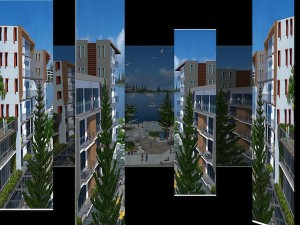
Artist impressions vary as to how high-density high-rise to 10 storeys – with 3600 units and 10,000 residents – might look
They freely gave their time to determine how to best accommodate a stepping off point for the bay, properly taking all the issues, constraints and community feelings into account. These issues included car parking, water views, weather constraints, straggly land use patterns near Toondah, viability of Cleveland’s commercial hub and environmental issues. [See below]
The workshop, in March 2014, was at the time the expression of interests were called for the Toondah Harbour PDA. The workshop’s aim was to examine the merits or otherwise of the Newman Government’s briefing document and make a determination based on the ‘Redlands 2030 Community Plan’ to upgrade Toondah Harbour Ferry Terminal and facilities and to revitalise Cleveland.
These professionally prepared plans were duly presented to the Redland City Council at no cost. Yet these carefully crafted guidelines that our committed team of professionals and locals set for themselves, have been completely ignored. Naturally, after seeing how a ferry terminal upgrade has been manipulated into an ambitious, environmentally damaging reclamation project, these folk are shocked and angry. Council’s Toondah Harbour proposal was an excuse to build 3,600 apartments in a ten storey high rise development whilst ignoring all community concerns.
A Much Preferred Stepping Off Point for North Stradbroke Island
After properly and carefully evaluating all the points detailed above related to the siting of the new harbour, this team of specialists came up with a grand idea that not only takes the constraints into account but provides untold opportunity. It is to site a new harbour on the west side of Cleveland Point, an area that already is oriented towards boating facilities [Volunteer Marine Rescue and Redlands Boat Club] and has entrance channels ready made that don’t impact on the bay’s fragile ecosystem. It will add just a few minutes journey time to/from Straddie. But just look what it gives us.
This is a proposal that:
- preserves one of the oldest green reserves in Queensland, the G J Walter Park
- conserves and thus enables us to promote the unique early colonial history of the area
- gives back the grand view to the Grand View Hotel – the oldest and grandest in Queensland
- provides an all-weather harbour that is protected from the elements – no risk of barges going aground
- will restore the important Toondah marine environ. [Existing channel cuts through seagrass meadow, coral habitat and significant Ramsar bird feeding site for endangered shorebirds]
Above all, it gives the Redlands an historic, waterside precinct with bay views intact and priceless bay breezes that stretches from the Grand View Hotel all the way down to include the ugly and dysfunctional Toondah Harbour site. With a mangrove boardwalk, it could even go further through to the Nandeebie and Oyster Point Parks. This bayside parkland can become the City’s unique focal parkland that will provide a premier site for events and festivals. Then, for the rest of the year, provide a beautiful green space that will serve as a reminder that the Redlands community and its Council have together set the right priorities and not given in to big business.
Look under Tourism opportunities for further ideas on this greenspace
Now Read the Comments from planning professionals about the Old Toondah proposal
Brit Anderson, Emeritus Professor of Architecture and Planning, University of Queensland, said:
“The Toondah Harbour PDA represents a grossly oversized and inappropriate project on a sensitive site. The implications are seriously problematic on many levels including the environmental, technical, social and architectural, with unknown future costs for the Redland City Council. The standard of this Toondah Harbour PDA proposal is not sufficient quality and is incomprehensible that this scheme or its underpinning assumptions are being considered by Government.”
*Shane Thompson, President of the Australian Institute of Architects. (He did the RNA development plan and Athletes Village at the London Olympics).
“This is a very poor quality piece of work and unworthy of the professionalism that should be expected and available in this part of the world and what the residents of the Redlands deserve. We can only assume that whoever has been responsible is inexperienced or has been inappropriately directed.”
Haig Beck, former Professor of Architecture and Urban Planning at Melbourne University, said:
“It would be in everyone’s interest to refrain the terms of the PDA process and restrict the objectives to the low key, upgrading of the port. This would have the advantage of delivering sorely needed infrastructure to Redlands without entailing the city mortgaging its future to a high-rise white elephant.”
Another workshop participant, in summarising the Council’s Toondah Harbour project, John Mainwaring – architect and marina consultant – said,
“This PDA proposal makes Queensland and Australia a laughing stock internationally and nationally.”
Another architect said,
“A strategic integrated urban renewable development program for Cleveland is what’s needed and it is inappropriate to consider Toondah Harbour in isolation. Instead of one big bang development at Toondah Harbour, many smaller developments to consolidate the city and disperse the risk was what was required.”
[Thanks to the above architects and particularly John Mainwaring, who helped put this article together]
Environmental impacts
We heard a lot about the controversial dredging for the Abbot Point Port Coal Terminal and its environmental impacts, but the nearest reef was 40kms away and the dredged area did not contain any seagrass beds. The Toondah Harbour project entails dredging 1.85 million cubic metres, both in and adjacent to vital wetlands. This will destroy 34 hectares of sea grass and a large area of tidal mudflats.
There’s also boating facilities for private and commercial craft that that haven’t been provided for, that would help keep the bay clean, like pump out facilities for waste holding tanks on boats.
It is now law that all commercial craft are fitted with holding tanks connected to their toilet and sink wastes. Also most new private vessels with a plumbed in toilet are similarly fitted with a holding tank. These craft must have pump-out facilities otherwise their waste goes untreated into the bay. Most waterways in the developed world that have heavy boat traffic like Moreton Bay, have passed laws stipulating that all craft have holding tanks and for local authorities to supply appropriate pump-out facilities. Queensland has been laggard in passing this important legislation but this doesn’t stop Redland City Council from acting.
This Toondah Harbour exercise has shown that instead of the Redlands City Council being the guardians of the public good and custodians of community held values, they’ve become the facilitators only of unceasing growth and development at all costs. It’s an example of technocratic planning – typical of the worst kind of council authority – that reinforces a ‘decide-announce-defend’ planning culture which minimizes citizen input
Click on this link for guided tour of Toondah Harbour wetlands site by Troy Robbins:
Threats resulting from the Shoreline Development
One of the particular challenges of a rapidly expanding city is its capacity to deliver the amenities required to allow for greater density. Those amenities include sewage systems, roads, public transport and shops. It’s a good idea for these to be carefully planned and costed before the development approvals. In fact in some countries, sewage systems and roads, sensibly have to be in place before the development can proceed.
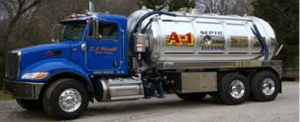 Yet for the first stage of the Shoreline project, the first 200 lots being developed will have their sewage tanked out by truck to treatment plants elsewhere. And this number may well escalate as no dollar figure has yet been put on the provision of a sewerage system as the developer has yet to design a facility that was efficient and viable. There is no site identified for this sewerage treatment plant or to accommodate the reticulation of waste water.
Yet for the first stage of the Shoreline project, the first 200 lots being developed will have their sewage tanked out by truck to treatment plants elsewhere. And this number may well escalate as no dollar figure has yet been put on the provision of a sewerage system as the developer has yet to design a facility that was efficient and viable. There is no site identified for this sewerage treatment plant or to accommodate the reticulation of waste water.
Any council approving a housing estate for up to 10,000 people without sewerage and waste water treatment is crazy.
Another challenge is to ensure that development is in line with need.
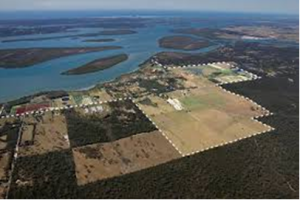 A report into residential development in the city by the planning consultants, Urbis, found there would be no housing shortfall in Redlands and hence no need for such a project until 2041.
A report into residential development in the city by the planning consultants, Urbis, found there would be no housing shortfall in Redlands and hence no need for such a project until 2041.
In early February 2016, a State Government department, the Planning Information and Forecasting Unit, (PIFU) released their latest figures on population predictions for SE Qld. Redlands figures have been reduced by 18,000. Yet Toondah and Shoreline populations alone are estimated at 20,000 residents and these developments were not included in the State forecasts. Some of the present Council don’t study the science or listen to experts, they just look after their donors.
There are other deep challenges with this development:

- It is not inside the Urban Footprint
- it is in a high mosquito zone
- it adjoins a Ramsar wetlands site of international significance
- it could be in breach of koala protection laws
There has been no state government commitment to fund an upgrade to Cleveland-Redland Bay Road. An area that already suffers traffic snarls and which has over 200 house lots already in the pipeline. The present proposal to upgrade some approach roads and roundabouts will not be enough to cope with another 5,000 plus cars using these roads.
Moreton Bay’s Shorebirds Under Threat
The shallow nature and vast intertidal zones of the southern half of Moreton Bay, makes it one of the world’s most significant wetland environments. The area of Moreton Bay under Redlands City Council control is the biggest of any of the 12 zones and has by far the longest intertidal zone. From the sandbanks on the Bay’s eastern side, the various littoral zones around the many islands, to the mangrove fringed mudflats in the west, they are each of critical importance and support a wide range of different species. They also have important recreational and commercial fishing grounds.
With our develop–at-all-costs council, little thought has been given to avoiding environmental impacts. A sensibly planned development would focus on the much needed harbour relocation without impacting on the tidal flats where migratory shorebirds have their stopover.
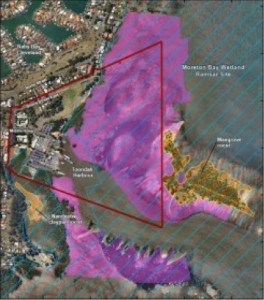
The areas where shorebirds feed is shown in purple on this map prepared by the specialist ecological consultants, BAAM
Environmental consultants BAAM have identified 10 species of migratory shorebird that feed or roost in and around the area proposed for development at Toondah Harbour. The areas where shorebirds feed is shown in purple on this map prepared by the specialist ecological consultants, Biodiversity Assessment and Management Pty Ltd (BAAM) is Queensland’s leading specialist ecological consultants. In their report on the Toondah harbour proposal they said that the intertidal seagrass beds are extensive, particularly in the northern section of this area and provides moderate to high value foraging habitat for migratory shorebirds, dugong and turtle and nursery areas for fish.
“Shore Birds in Crisis”, a document by Birdlife Australia profiling endangered migratory shorebirds is available for download here:
http://birdlife.org.au/documents/WMBD-Species-Profiles-2015.pdf
Commenting on plans for development at Toondah Harbour, Convenor of BirdLife Southern Queensland, Judith Hoyle says:
These migratory shorebirds are on the brink of extinction. Their survival depends on conservation of their feeding grounds along the entire Eastern Flyway. Birds which feed and roost in the Toondah Harbour area have experienced some of the largest population declines recorded over the past 30 years: Eastern Curlews have declined by 80.5% and Bar-tailed Godwits have declined by 79.1% The Great Knot has declined by 77.8%.
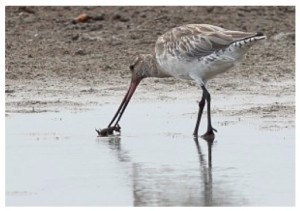
Bar-tailed Godwit feeding on proposed Toondah Harbour development site
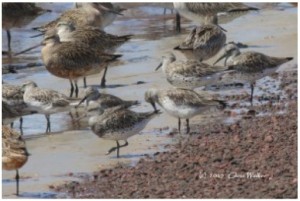
The Great Knot
The Great Knot is a small wader. Its breeding habitat is in northeast Siberia. After flying all that way, are we now going to make this endangered international traveller unwelcome and help it on its way to extinction?
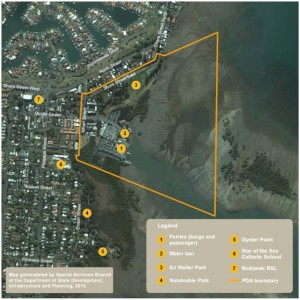
Toondah Harbour Priority Development Area
The Toondah Harbour Priority Development Area (PDA) includes about 50 hectares that will be reclaimed from these invaluable wetland and shallow water areas, which are part of the Moreton Bay Ramsar site.
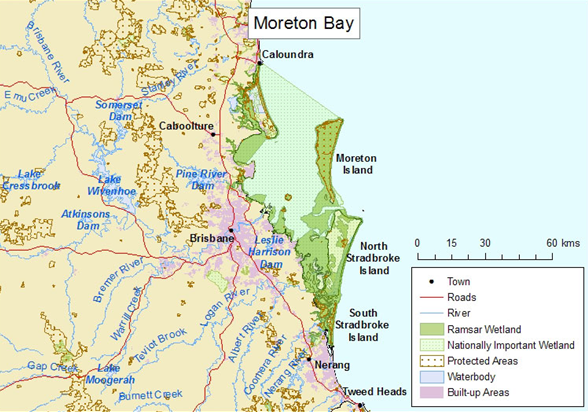
Map of Moreton Bay Ramsar Wetlands
Ramsar wetlands are areas that have been identified as representative, rare or unique wetlands, or are important for conserving biological diversity and are of international importance. The Redlands has the largest area of Ramsar wetland in Moreton Bay. They are feeding area for migratory shorebirds and is significant habitat for loggerhead turtles – the most important population along the east coast of Australia. They are now listed as ’endangered to extinction’.
The Toondah Harbour developers say they will be able to create an offset that will mitigate the loss of over 43 hectares of shorebird habitat. But the science refutes this. Although artificial roosts can be made, artificial feeding grounds simply cannot be created.
No feeding grounds = no birds

Bar-tailed Godwits leaving the roost at Oyster Point near Toondah Harbour

Bush Stone-curlews at home in the saltmarsh
Resident seabirds and shorebirds include herons, terns, oystercatchers, egrets and cormorants and each year Moreton Bay is visited by 50,000 migratory shorebirds. From October to April – more than 30 different shorebird species live in this area busy feeding to build up energy for their return trip to East Asia.
The largest is the internationally vulnerable Eastern Curlew notable for its long curved bill. The smallest of these international travellers is the red-necked stint. At low tide, shorebirds wander over exposed sandbanks, seagrass beds and mudflats to feed. When the tide rises, birds gather in hundreds at roosting areas like Oyster Point which is just south of Toondah Harbour.
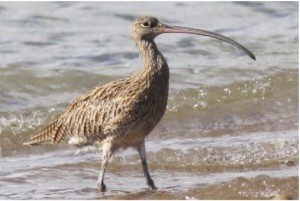
The Eastern Curlew
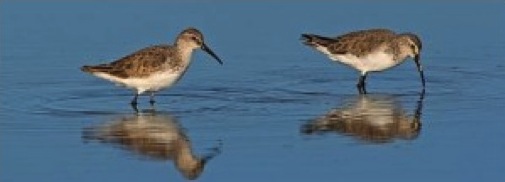
Curlew Sandpipers
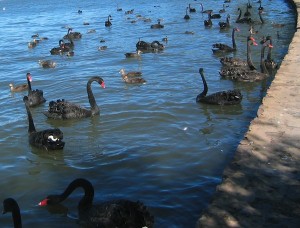
People associate black swans with Western Australia, but we once had massive flocks right here in Moreton Bay. Read the stories by the 19th century naturalist, Thomas Welsby, of his time spent in Moreton Bay and how the sky went dark as flocks of black swans – numbering in their thousands – flew overhead. Sail the entire length of the bay from Caloundra to Southport today and you’ll be very lucky if you encounter 3 or 4 birds. Invariably you won’t see any
A recent feature story on Shorebirds on ABC’s website is here:
http://www.abc.net.au/news/2016-06-17/flying-for-your-life-ann-jones/7459288
Excellent video on Moreton Bay’s Shorebirds: https://www.youtube.com/watch?v=t8ByuyYxgSk
Threats to fishing and marine life in Moreton Bay.
30% of all marine life depend on coral for their survival and that includes fish in Moreton Bay.
Coral scientist, Dr Charlie Veron, says that dredging is one of the biggest killers of coral, such as when channels are deepened for harbours such as Townsville and, he says, “Once corals go – fish follow”. This should be of great concern to us all but particularly amateur and commercial fishermen and oystermen, because Coral – like mangroves – is vital to marine life.
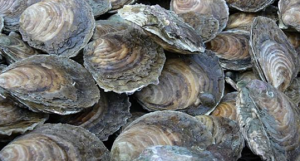
Moreton Bay Oysters
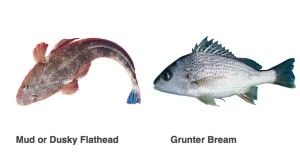
As the bumper sticker says: I fish I vote. Well – join in, vote accordingly and help stop Toondah and Shoreline developments
One cause of shrinking fish catches is mangrove destruction. Mangrove environments are a vital marine ecosystem and a critical sanctuary and food source for juvenile fish. Of the twelve Healthy Waterways zones, there have been more mangroves destroyed in the Redlands than any other zones in the last 35 years. Principally to construct the Raby Bay canal development shown here, but also at Aquatic Paradise and at some of the bay islands.
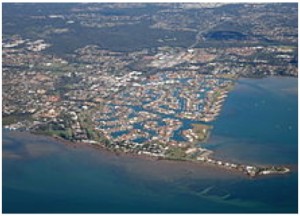
Raby Bay, Cleveland
Scientific and government surveys show that fishers support the highly protected sanctuaries within our marine parks. That’s because they protect our fish and our marine environment. The importance of advocacy in influencing the policies and legislation that govern recreational anglers’ access and use of the resource, in addition to how habitats are protected and managed, cannot be underestimated. Around Australia, angling clubs and individual anglers devote significant time promoting the sustainable management of the resource on which they depend.
Moreton Bay has many diverse marine ecosystems that are interdependent and it’s the unique geography of the region which provides the sheltered sanctuaries for it to thrive. A major dredging operation threatens the survival of these precious ecosystems.
The proposed area for the Toondah Harbour development is an important Moreton Bay Ramsar wetlands. It is composed of mangroves, mudflats and seagrass beds that provide homes and food for a diverse range of tens of thousands of amazing marine and terrestrial creatures both big and small.
Moreton Bay is also a natural heritage resource that underpins tourism, diving and resorts along with amateur and professional fisheries and island and coastal development. This is known as the ‘Blue Economy”.
Look at the bay’s fish catches from just 35 – 40 years ago
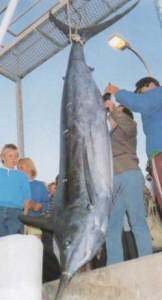
360lb Blue Marlin
It was from the game fishing boat, Warrigal that the first blue marlin was taken from Moreton Bay in 1981 and officially weighed in at 360 lb. At the time it was said that this marlin could lead to the development of big game fishing in the Bay.
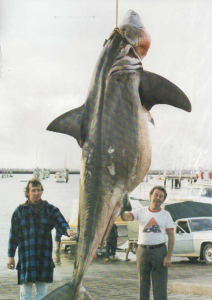
White Pointer Shark
This was the biggest white pointer shark taken anywhere in the world in the decade from 1976 to 1985. It was caught with with 80 lb. game fish tackle in Moreton Bay and weighed in at 1,808 lb. The angler was Arthur Prince and the wire man Dave Ross. It was caught between Peel Island and North Stradbroke Island. Many other world records have been caught in Moreton Bay.
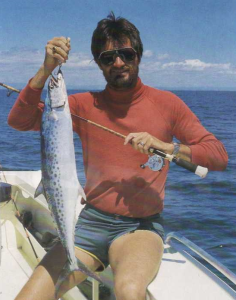
This spotted mackerel was an Australian record for many years. It was caught on a 2 lb line by Wayne Osborne in Moreton Bay in 1983
All these record breaking catches were made in Moreton Bay in the 1970s-80s and have not been repeated since. And this depletion in both size and quantity of the bay’s fish is happening at an ever increasing rate.
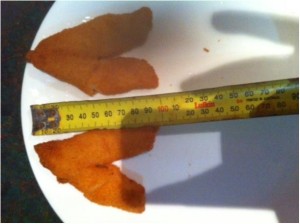
Whiting now sold in fish shops
The average size of some locally caught species of whiting are a little over 10 cms in length, whereas just 25 years ago the average catch size was between 22 and 26cms. Part of the problem is that catches by recreational fishermen now exceeds the catches by professionals. Studies have shown that in Queensland over twice the amount of fish is taken by anglers. One of the principle causes of their success is the new fish finding technologies – rapidly killing off the very reason they were invented.
Read even earlier accounts of early Moreton Bay explorers and fishermen and you realize what we’ve lost
Thomas Welsby describes how in the 1860’s, a couple of men fishing with hand lines would continually haul aboard fish weighing 4 to 6kg and would have to stop after 30 minutes for fear of sinking their boat.
Moreton Bay is also a natural and cultural heritage resource that underpins tourism, diving and resorts along with amateur and professional fisheries and island and coastal development. The Moreton Bay commercial fishery is still one of the most important fisheries in Queensland and its values should be protected.
Moreton Bay’s corals
Dredging throws up fine sediment into the water, increasing turbidity and deadly plumes drift for many kilometres with the tide, degrading water quality and smothering and killing seagrass beds and coral.
Some of the bay’s corals are found nowhere else in the world and the risk of damage has attracted the scorn of one of Australia’s top marine scientists.
Dr ’Charlie’ Veron, is one of the world’s leading authorities on coral. He has identified and named many coral species and, for many years was the Chief Scientist of the Australian Institute of Marine Science.
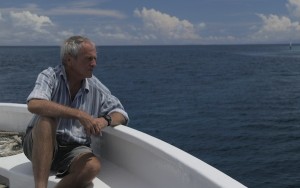
Dr ’Charlie’ Veron
Charlie has discovered nearly a ¼ of the world’s coral species, and mapped and re-described them all.
Charlie says:
“Unknown to most people, Moreton Bay has an extraordinary diversity of corals [and] the coral communities of Moreton Bay are so unusual they have few parallels anywhere in the world and none in Australia. This observation can hardly be overstated. For example, the most recently discovered of all corals, Heteropsammia moretonensis, is found nowhere else. For another example, I named Astreopora moretonensis after the region because it is common and forms large colonies there, but is rarely seen elsewhere. The word ‘unique’ is often overplayed but the corals of Moreton Bay are indeed that, to an exceptional degree.”
Charlie, who single-handedly put a halt to the plan to dump dredging spoil from Abbot Point on to the Great Barrier Reef, says that deadly drifting plumes cause sedimentation, the biggest killer of corals as it blocks sunlight and stops photosynthesis. He says:
“Terrigenous sediment is the fine-grained sediment that comes originally from land via rivers and accumulates as mud on the ocean floor … This mud is a killer as it interferes with most life functions of corals and most other marine life, including food ingestion and reproduction. Also, it stays in the water column as plumes for protracted periods of time and therefore gets dispersed widely, cutting back the light that is essential to corals. Most corals that have been impacted by mud from dredges die for these reasons.”
Coral reefs are known as the ‘rainforests’ of the sea because of their enormous diversity of life. They cover less than 0.2% of the ocean floor, yet provide a home for around 25% of the oceans species.
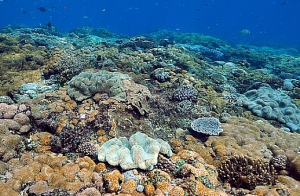
Moreton Bay Coral
Dr Veron says: “Moreton Bay is not part of the Great Barrier Reef and nothing like its coral communities are found in the Great Barrier Reef Marine Park or anywhere else. The only other east Australian coastal area known for its corals are the Solitary Islands which, for the past 25 years, has been a hands-on managed marine park. Moreton Bay coral gardens are just as extensive as those of the Solitary Islands and warrant the same level of protection.”
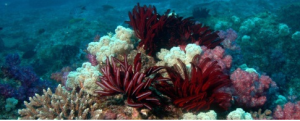
Coral at Flinders Reef
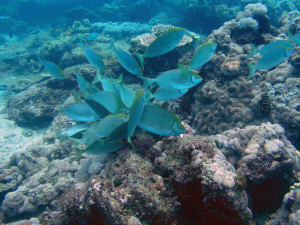
Moreton Bay Coral
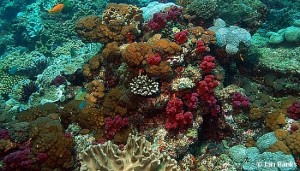
Coral off Pt Lookout
The Moreton Bay Marine Park and surrounding area, including Flinders Reef, has 173 species in 42 genera, about a quarter of all species of the Indo-Pacific. A high proportion of these have growth-form variations seldom seen elsewhere.
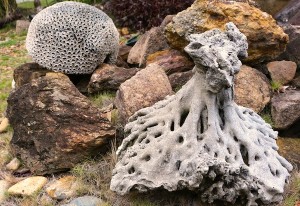
Ancient coral from St Helena Island
This is some of the coral retrieved from old coral beds at St Helena Island. A total of 62 species of coral still live in Moreton Bay but there was once a lot more. Mud is the big killer and between the 1840s and 1880s settlers cleared 70 per cent of the bay’s catchment of trees, resulting in constant mud plumes that caused many corals to die off in the bay. Mud, St Helena and Green islands once had beautiful coral reefs but these were largely destroyed by mining the rubble from ancient coral beds (calcium carbonate) for cement making for 60 years from the mid 1930’s. Mud plumes and pollution from dredging the Brisbane River is harming the remainder. Around Mud and St Helena Islands, as in much of the western bay, some corals still grow on these old subfossil fringing reefs. Another 120 species exist at Flinders Reef and Flat Rock off Point Lookout, North Stradbroke Island, but all these bay and ocean corals are now under threat from mud from the proposed dredging at Toondah harbour
The Mud Zone
Because the bay is muddy on its western side, it deceives us into thinking that there’s not much life down there. But there’s millions of critters down in what divers call the ‘muck zone’. It’s a term they use to describe the muddy bottom, seagrass beds, patchy reef and shell rubble where many diverse species eke out an existence in the gloom and this is where birds feed at low tide. This applies to the proposed Toondah site dredging area.
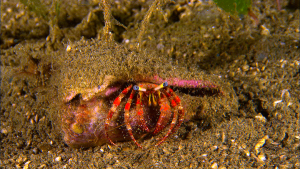
Moreton Bay Hermit Crab
One resident of these proposed dredging areas is the hermit crab and one estimate put the population in one 50metre by 50 metre area as being over 130,000. They have large fleshy soft abdomens that they protect by hiding them in discarded snail shells where they spend their entire lives. Just swapping them for bigger ones as they grow.
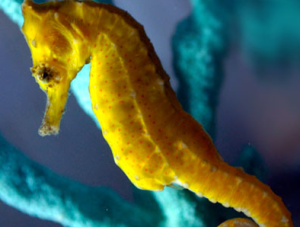
Moreton Bay Seahorse
Moreton Bay also boasts a number of seahorse species, including the Low-crown seahorse (Hippocampus dahlia), and the High-crown seahorse (Hippocampus procerus). Seahorses are often seen in the seagrass beds.
Moreton Bay’s diversity is unique: over the years Moreton Bay Marine Park has recorded:
- over 750 species of fish
- over 120 species of coral
- the highest diversity and abundance of whales and dolphins in Australia
- the world’s largest population of dugong next to a capital city
- populations of the endangered grey nurse shark
- six of the world’s seven species of marine turtles
Threats to the Bay’s Turtle and Dugong
It’s not just mud that dredging stirs up; toxic compounds, chemical pollutants and plastic debris that have settled in the muddy layers are dispersed that can poison, entangle and choke birds and turtles.
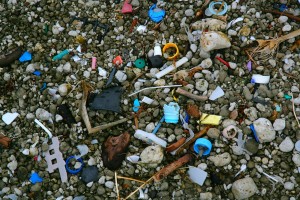
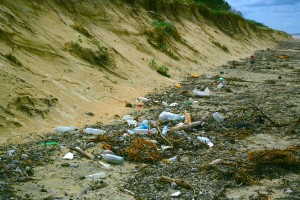
Plastic and rubbish on bay’s beaches
Marine turtles are particularly vulnerable to debris because the shape of their spines means they can easily swallow debris but cannot throw it back up. Plastic blocks the gut and inhibits digestion of food. Undigested food then decomposes and emits gases which affects the turtle’s buoyancy, causing it to float, where it starves or gets struck by boats.
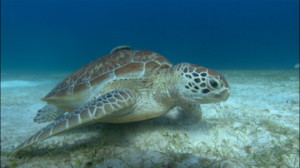
Green Turtle on Seagrass
The Bay’s seagrass beds supports many species of turtles including Green, Hawkesbill and Loggerhead.
Matthew Flinders as he sailed into Moreton Bay in 1799 described herds of several hundred dugong surrounding his boat. Even in the early 1980’s dugong were a regular sighting west of Wellington Point and around the Toondah harbour area. Also around the entrance to the Rouse Channel. Sightings are rare in these areas today and you have to go to the shallows off the south west of Moreton Island to see them. But even here the numbers are a small fraction of what was there in the early 80’s.
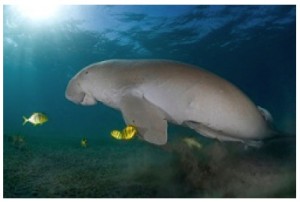
Dugong in Moreton Bay
These unique mammals are solely dependent on seagrass beds in the bay and need over 30kg of it every day. They are long-lived but are extremely slow to produce. Females are in their teens before they begin breeding. They then have only one calf every four to six years, so adult survival must be high for the population to survive.
Moreton Bay is the only place in the world where turtles and dugong still live on the doorstep of a major population centre. Dugongs are currently listed as vulnerable to extinction by the International Union for Conservation of Nature (IUCN) as there have been significant declines in populations over the past century.
We’re privileged to have these creatures at our doorstep, so let’s take steps to look after them.
Stormwater management
Even before the threats from dredging, the Redlands environmental track record is already one of serious concern. Just ask Healthy Waterways – an independent, not-for-profit organisation working hard to protect South East Queensland’s waterways by monitoring water quality in the bay’s catchments.
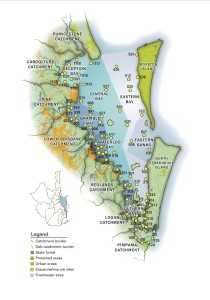
Numerous creeks and rivers feed into Moreton Bay. What happens upstream influences what happens downstream
For over two decades Healthy Waterways have been monitoring the declining health of the 12 council zones of the Moreton Bay catchment and publicising their ratings of its health on an annual basis. Some councils have taken heed of their warnings and cleaned up their act.
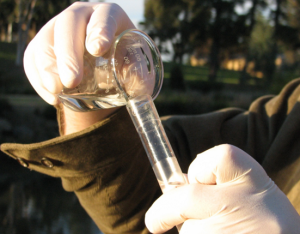
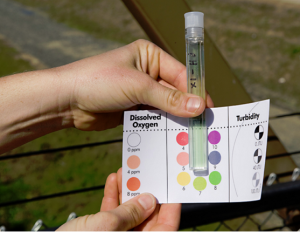
But the Redlands rating has declined over the years and in 2015 it was C+. Only two zones – the large industrial zone of the lower Brisbane River and the high density zone of Nerang had a lower rating than the Redlands. Why is this happening?
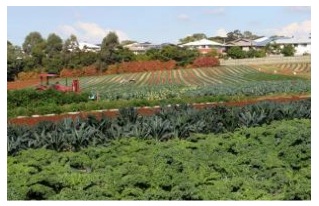
Run off from farms can pollute
Redlands was, and in some cases still is, an area with lots of agriculture with high concentrations of nitrogen and phosphorous fertilizers, herbicides and pesticides. Add to this the impacts of home gardens and lawns where chemical use is high. This results in excessively high nutrient loads flowing into the bay. This can contribute to poisonous algal blooms but can be mitigated through ensuring stormwater pass through natural filters or sinks. In other areas, Gross Pollution Detention Traps (GPDT) have been used to capture some of these sediment as harmful plastics and other wastes have been shown to have a serious impact on marine life. Natural habitats can serve to trap or immobilize chemicals such as plant nutrients, organic pollutants, or metal ions through natural processes. So a drain that enters a swamp, wetland or slow moving creek may carry a substantial amount of pollutants but the natural biological activity of the waterway will remove them.
All forms of run off from land cannot just be allowed to flow unimpeded straight into the bay due to the pollution and sediment loads carried but …
Redlands City Council at times operates on the outdated maxim – that “the solution to pollution is dilution”

Building sites can pollute waterways
Wherever land clearing takes place or farmland is developed into housing there are problems with soil erosion particularly where barriers or practices to capture sediments are not implemented or maintained. These produce large quantities of sediment and pollutants. Natural habitat acts as a filter but roads and concrete gutters and drains, as you see in following photo, allow runoff to flow quickly and untreated into the bay.
In the Redlands, the estuarine water quality is only fair and the catchment is under pressure from poor stream health and high sediment and nutrient loads which are being generated from intense urban land use. The standards of stormwater runoff has had a significant impact on the overall grade for our catchment. In addition to stream health condition, the high amount of sediment and nutrient loads entering Redland’s waterways affected the overall catchment grade. It was estimated that there were 4,120 tonnes of sediment generated from all types of land use and approximately 36% of streams in Redland have remnant vegetation, 50% have minimal vegetation and the remaining 14% – vegetation is absent.
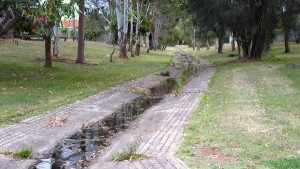
The “Wild Guide to Moreton Bay” published by the Queensland Museum states:
“It is vital that we all make the connection between the loss of bushland at the end of the street, the filling of wetlands or the channelisation of creeks, and the effect that this might eventually have on the health of the Bay. Each small act may seem insignificant in its own right; however when multiplied together they have a considerable impact.”
There are many landholders and community groups dedicating their time to the protection and improvement of our waterways through activities such as riverbank stabilisation, tree plantings and picking up litter, but council have to do their bit.
Waterways have to be protected from plastic debris and proper filtering of stormwater is essential. Plastic degrades only slowly and turtles and birds thinks its food.
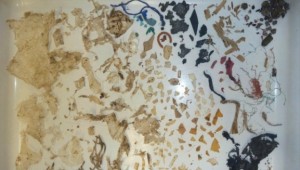
Over 30% of the bay’s turtles are found to have ingested large quantities of plastic
Just take a look at the contents of one Australian green turtle’s stomach. Laid out on a laboratory bench by Dr Qamar Schuyler, are plastic bag and balloon fragments, string, packing strap and sharp chips and contributed to the death of this green turtle found in part of ocean adjacent to Moreton Bay. Over 30% of the bay’s turtles are found to have ingested large quantities of plastic
Marine turtles are particularly vulnerable to debris because the shape of their spines means they can easily swallow debris but cannot throw it back up. Plastic blocks the gut and inhibits digestion of food. Undigested food then decomposes and emits gases which affects the turtle’s buoyancy, causing it to float, where it starves or gets struck by boats.
Worldwide, plastic has wound up in the stomachs of more than half the world’s sea turtles.
The World Economic Forum study estimates that if we keep producing (and failing to properly dispose of) plastics at predicted rates, plastics in the ocean will outweigh fish pound for pound by 2050, the nonprofit foundation said in a report in March 2016.
As the council with the largest and most important sector of Moreton Bay under its control, wouldn’t it be good if instead of being one of the worst performing councils, if we got our house in order instead and, with our rate payers funds, set a shining example in how to conduct proper waterway management?
Threats to the islands and the bay from the ‘Bridge to Straddie’ proposal
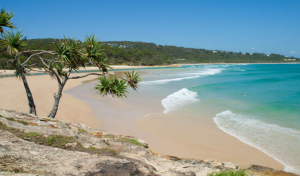
The most appealing features of Straddie is of course that it’s an island and, like any island, it’s charm results from having all its many assets protected by its limited access.
Although it’s close to the two major population centres of Queensland: Brisbane and the Gold Coast … …it has managed to retain that charm
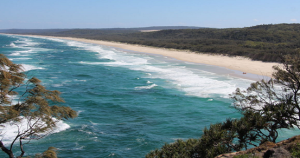
This proximity is a threat: build a bridge and it becomes just an easily accessed, overcrowded extension of the mainland; like Bribie
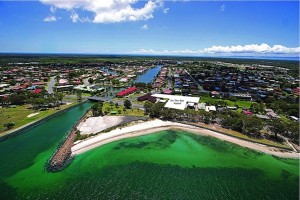
… complete with canal developments and major townships. All this development you see – plus a lot more – happened after the building of the bridge to Bribie. Also a bridge would connect up some of the intervening islands like Russell and turn them into overdeveloped Bribie look-alikes also.
Is this we how we want Straddie and Russell Island to look?
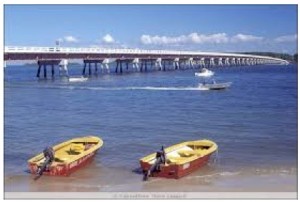
Road bridge to Bribie Island
A bridge to the island wouldn’t be high like the Gateway bridge, it would be low like the road bridge to Bribie Island. Thus a barrier to all boats with masts.
A bridge of this height would cut off all north-south access through the bay for sailing boats and large power boats heading from Brisbane to the Gold Coast and return, which is a much safer and shorter route than the offshore passage they would be forced to take instead.
Developers and real estate agents may be in favour of a bridge as they can see development opportunities and enhanced real estate prices, but as with other issues in the Redlands – there are other more important priorities to consider – a question of balance.
A bridge to Straddie is a big threat to the island, but the other threat the Island faces is the possible extension to sandmining if the State Government fails to act. The fact is that the cessation of sand mining on the island is a huge opportunity for tourism which has the potential to more than make up for the loss of the sandmining industry.
– Click on this link for TOURISM OPPORTUNITIES
I’m Moreton Bay – Please help me! – a poem
There are a great variety of folk who regularly go out to work, play and research in Moreton Bay. They range from bird-watchers to ferry and charter boat captains, National Park rangers, skippers of yachts and trawlers, oystermen, canoeists and private anglers.
They’re a diverse bunch of people from all walks of life but if you speak to them, they all have one thing in common. They are all deeply concerned about the dramatic decline in numbers of wildlife they’ve observed over the years.
In the mid 1990’s, ecotours were started on St Helena Island which highlighted the sustainable use of Moreton Bay by its Indigenous population for over 10,000. The tours then compared this with our more damaging use of it during the last 180 years. To publicize these tours a poem was written on the bay’s behalf. It’s the bay, pleading for help.
I’m Moreton Bay – Please help me!
From Southport to Caloundra – I stretch for 70 nautical miles
My grey and choppy waters have one hundred and fifty five isles
Aborigenes knew how to treat me – for 10,000 years and more
They called me Quandamooka – and lived off my abundant store
I’m now on Brisbane’s doorstep and take her sewage by the ton
And as I am so shallow, that really ain’t much fun
On the West my dirty waters – oh the smell – I feel quite faint
From the junk you put in me – the chemicals, grease and paint
I take the muck from all your gutters, the oil from all your boats
Some stuff it sinks to the bottom … others it just floats
Birds feed on all the plastic bits – they think it’s food in glut
But the poor things end up dying with plastic stuck in their gut
Adult fish are getting smaller – my turtles just won’t stay
Dugong are disappearing – my birds are flying away
Yet treat’em with consideration, look after them in style
Take care what you put in me – they’ll be round for quite a while
All your breezy yachties can take all the wind they wish
I can be your playground, you can snorkel, swim and fish
Freshen up my dirty waters – take care of what you’ve got
Keep me clean and healthy …or you’ll lose the blooming lot
Graham Carter
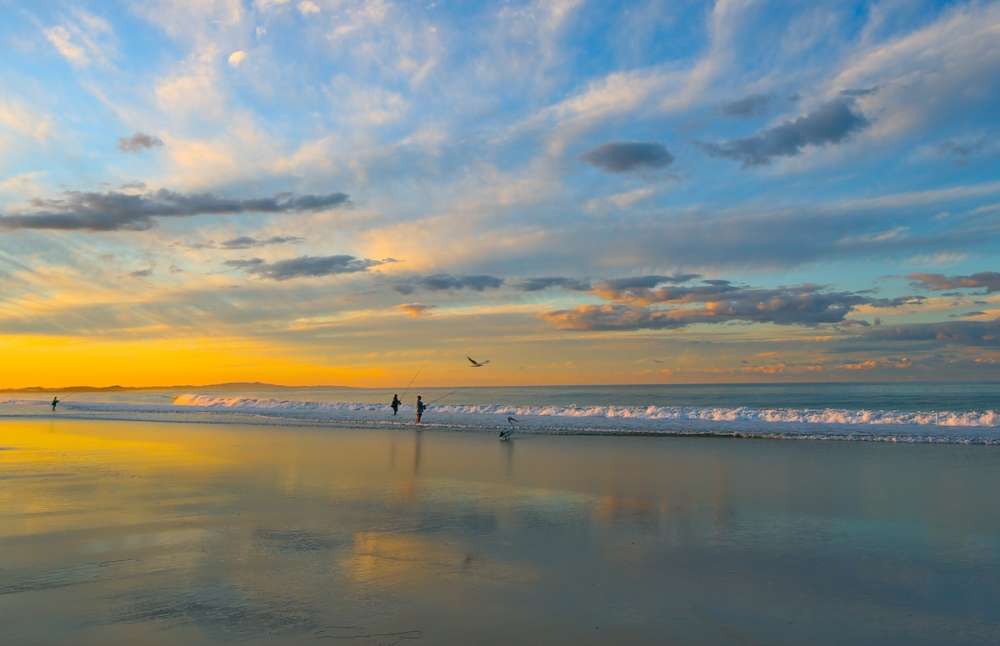
The bay’s health has declined significantly since that poem was written 20 years ago – yet Redlands City Council is about to put the bay under its greatest threat ever with a huge residential development on 60 hectares of land reclaimed from the Bay and destruction of marine habitats
We can’t let this destruction continue.
Author : Graham Carter
With many thanks for the help provided by the following people
(but all commentary and mistakes are the author’s)
Voiceovers: Brian Cannon, Carolyn Parsons
Imagery: Ocean Ark Alliance, Lara Rowe
Text: Debra Henry, Simon Baltais, Dr Qamar Schuyler, Dr Sue Pillans, Troy Robbins, Judith Hoyle, Jackie Cooper, Dr Jan Aldenhoven, Noel Dawson, Fiona Maxwell, Dr Doug Moore, Greg Underwood, Wendy Boglary, Craig Ogilvie, Dr Richard Fuller, Jay Donaldson, Peter Simon, David Hannan, Steve MacDonald & the Redlands 2030 team, Redlands Tourism, The Redland City Bulletin, Wildlife Preservation Society of Qld, AMCS … etc …


